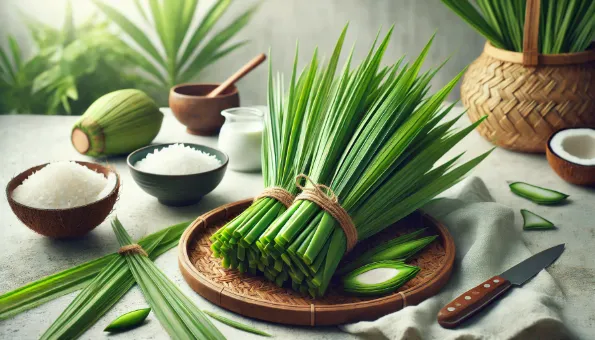Pandan Leaves: Fragrant Tropical Blade Herb Adding Vanilla–Almond–Jasmine Aroma With Minimal Calories
Long green leaves of *Pandanus amaryllifolius* lend sweet, nutty, floral notes (vanilla-almond-jasmine) plus natural green pigments and trace antioxidants—used fresh, bruised, knotted, juiced or as an infused wrap.

What Are Pandan Leaves?
Pandan (screwpine) leaves are **strap-like, aromatic leaves** from a sterile cultivated tropical plant (*Pandanus amaryllifolius*) widely used across Southeast and South Asia as a **natural flavor & color**. They contribute a distinctive sweet, nutty, floral aroma often likened to vanilla, almond, jasmine and newly steamed rice.
Key Aroma Compounds
- **2-Acetyl-1-pyrroline (2-AP):** Same compound responsible for the popcorn / basmati rice note.
- **Lactones & aldehydes** provide creamy, coconut-like nuance.
- **Terpenes & phenolics** add subtle green/floral complexity.
Bruising or blending ruptures cells, releasing these volatile compounds.
Nutrition (Typical Culinary Use)
Used primarily as a **flavoring**; leaves are usually removed (not eaten in bulk). Negligible calories, macronutrients & micronutrients per serving. Pandan juice (blended leaves + water) carries **chlorophyll, trace carotenoids & phenolic antioxidants**, but in modest amounts versus leafy vegetables.
Potential Benefits
- **Calorie-free flavor enhancer**: enables sweetness perception and dessert appeal with less added sugar.
- **Natural green color** alternative to synthetic dyes in cakes, rice, custards.
- **Aromatic 2-AP synergy** with coconut & rice heightens overall flavor satisfaction → may support portion control (indirect).
- **Wrapping/infusing technique** adds aroma without added fats or sodium.
Drawbacks & Precautions
- **Perishable fresh leaves** wilt & lose aroma; frozen quality varies.
- Overuse or prolonged high heat can yield **grassy / slightly bitter notes**.
- Commercial bottled pandan extracts may contain **artificial coloring & added sugar**—check labels.
- Minimal direct nutritional value; treat as a culinary enhancer, not a nutrient source.
Culinary Applications
- **Infused rice / coconut milk:** Knot 2–3 leaves and simmer; remove before serving.
- **Pandan juice/paste:** Blend chopped leaves with a little water; strain; rest to let green sediment settle for vibrant color in cakes (pandan chiffon), kaya jam, waffles.
- **Wrapping:** Fold into packets around chicken, fish or sticky rice (Thai pandan chicken) then fry, steam or bake—leaf protects moisture & perfumes.
- **Desserts & drinks:** Syrups, agar jellies, custards, milk teas, smoothies.
- **Savory aroma:** Add to curries or stews for subtle background sweetness (remove before serving).
Technique & Optimization
- **Bruise / knot** leaves to increase surface area & oil release.
- For juice, **cut leaves finely** (scissors) before blending; high-speed blend with minimal water, strain, then chill (color stabilizes).
- Combine with **coconut, palm sugar, vanilla or jasmine rice** to amplify synergies.
- Avoid long vigorous boiling (>30–40 min) which dissipates delicate volatiles; use gentle simmer or late addition.
- Freeze extra juice in ice cube trays; use directly in batters or rice cooking liquid.
Selecting & Handling
Choose **deep green, glossy, un-split leaves** without yellowing tips. Rinse, pat dry. For maximum aroma, use within a few days or **freeze whole leaves flat** in an airtight bag (aroma declines slowly over months).
Sustainability Notes
Pandan is typically grown in small household or garden plots and can be harvested **leaf-by-leaf**, allowing continuous regrowth. Low input requirements (shade tolerant, modest water) make it a relatively **low-impact flavor crop**. Using pandan reduces reliance on artificial colorants and flavorings.
Storage
Wrap fresh leaves loosely in **damp paper towel + perforated bag**; refrigerate 3–5 days. For longer storage: freeze (whole or chopped) up to 6 months. Prepared juice keeps 2–3 days refrigerated; stir before use (natural separation).
Key Takeaways
✔︎ Highly aromatic, calorie-light flavor & natural green color
✔︎ Synergizes with coconut, rice & palm sugar in sweet or savory dishes
✖︎ Perishable; provides aroma rather than significant nutrition.
- 1. Pandan Leaves
Used for its natural sweetness and aroma

